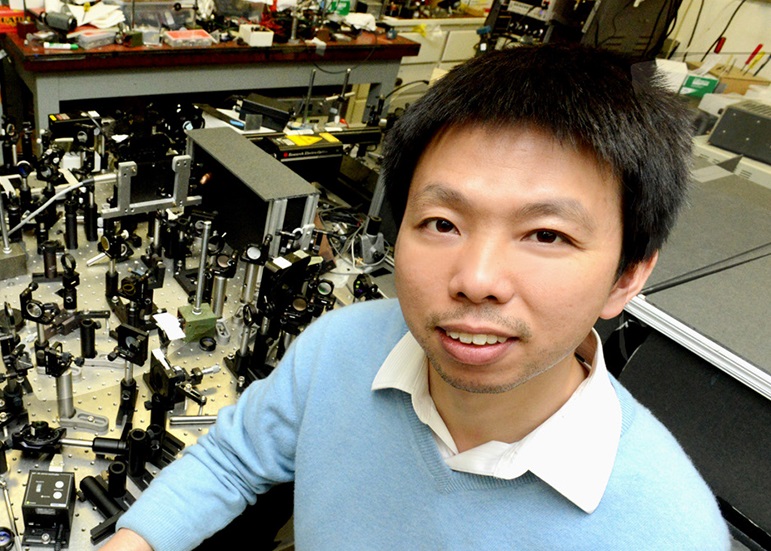Feng Wang received a B.A. from Fudan University, Shanghai, in 1999 and a Ph.D. from Columbia University in 2004. From 2005-2007, he has been a Miller Fellow with Miller Institute for Basic Science at Berkeley. He joined the physics faculty in fall, 2007.
Research Interests
We are interested in light-matter interaction in condensed matter physics, with an emphasis on novel physical phenomena emerging in nanoscale structures and at surfaces/interfaces. When electrons and phonons are confined in nanometer scale or at surface/interfaces, they respond differently to external stimuli. We investigate the unique nature and dynamics of such excited states using advanced laser spectroscopy techniques. Our laser spectroscopy has sensitivity down to individual nanostructures, together with time resolution of femtoseconds and spectral coverage extending from far-infrared, visible to UV.
Current Projects
Graphene optics: Graphene is a novel two dimensional material with extraordinary electrical and mechanical properties. It also has promising optical and optoelectronic properties: their low energy transitions can be continuously tuned by a gate voltage and fundamentally different behaviors are expected for single- and double- layered graphene. We are developing sensitive infrared spectroscopy using a microscopy setup with a femtosecond tunable light source. This will allow us to probe a wide range of graphene physics, from infrared electro-optic effect and graphene interlayer coupling to dynamics of electronic excitations and electron-phonon interactions.
Optical spectroscopy of individual nanotubes: Carbon nanotubes are a rich family of one-dimensional structures. They can be either semiconducting or metallic and their properties depend sensitively on the exact nanotube structure. To elucidate their different behaviors, studies of individual nanotubes are needed. We have had extended experience on single nanotube spectroscopy. We are also developing nonlinear probes of individual nanotubes that have not been explored before. It will allow investigation of phenomena ranging from optical stark effect, Rabbi oscillation and coherent excitation in one-dimensional structure. Further, time-resolved pump-probe measurements along individual nanotubes could yield direct information on carrier motion relevant to electrical and thermal transport. We are also collaborating with different groups in Berkeley to combine optical probes with mechanical, electrical, TEM and photo-emission characterizations.
Plasmonics: The collective excitation of plasmon resonances in metal nanostructures can act as an optical antenna and localize electromagnetic energy on the nanoscale. The enhancement of local electric fields can be so strong that Raman scattering from single molecules becomes detectable. The plasmon resonance is also expected to dramatically enhance nonlinear optical response. We are investigating its manifestation and the optimal structure design using nonlinear spectroscopy in conjunction with theoretical modeling.
Spectroscopy of Oxide Surface/Interface: With the development of epitaxial growth of oxides, many exciting and unexpected physical phenomena are being discovered at oxides interfaces. However, their physical understanding is hampered by a dearth of characterization tools capable of probing the buried interfaces. Second-order nonlinear spectroscopy, such as sum-frequency generation, is ideally suited for such study with its surface specificity and spectral resolution. We will apply it to investigate the electronic structure, vibrations and coupling between charge and lattice at oxide interfaces.
Publications
F. Wang , D. Cho, B. Kessler, J. Deslippe, P.J. Schuck, S.G. Louie, A. Zettl, T.F. Heinz, Y.R. Shen, “Observation of Excitons in One-Dimensional Metallic Single-Walled Carbon Nanotubes”, Phys. Rev. Lett. accepted (2007)
F. Wang , W.T. Liu, Y. Wu, M.Y. Sfeir, L.M. Huang, J. Hone, S. O’Brien, L.E. Brus, T.F. Heinz and Y.R. Shen, “Multiphonon Raman Scattering from Individual Single-Walled Carbon Nanotubes”, Phys. Rev. Lett. 98, 047402 (2007) .
F. Wang and Y.R. Shen, “General Properties of Local Plasmons in Metal Nanostructures”, Phys. Rev. Lett. 97, 206806 (2006)
F. Wang , J. Shan, I.A. Mohammad, I.P. Herman, M. Bonn and T.F. Heinz, “Exciton Polarizability in Semiconductor Nanocrystals”, Nature Materials, 5, 861 (2006).
M.Y. Sfeir, T. Beetz, F. Wang, L.M. Huang, X.M.H. Huang, M.Y. Huang, J. Hone, S. O’Brien, J.A. Misewich, T.F. Heinz, L.J. Wu, Y.M. Zhu and L.E. Brus, “Optical Spectroscopy of Individual Single-Walled Carbon Nanotubes of Defined Chiral Structure”, Science, 312, 554 (2006).
F. Wang *, G. Dukovic *, L.E. Brus, and T.F. Heinz “ The optical resonances in carbon nanotubes arise from excitons ”, Science, 308, 838 (2005).
M.Y. Sfeir *, F. Wang *, L. Huang, C.C. Chuang, J. Hone, S.P. O'Brien, T.F. Heinz, and L.E. Brus, “Probing Electronic Transitions in Individual Carbon Nanotubes by Rayleigh Scattering,” Science, 306, 1540 (2004).
L. Bartels, F. Wang, D. Moeller, E. Knoesel, and T.F. Heinz, “Real-Space Observation of Molecular Motion Induced by Femtosecond Laser Pulses,” Science 305,648 (2004).

